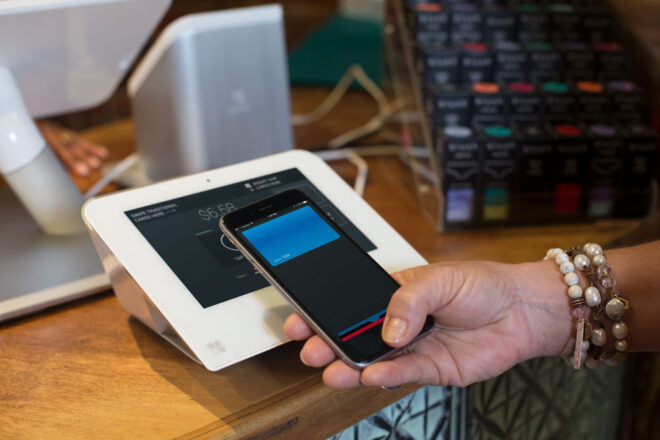If you’re a small business owner contemplating going cashless, consider this: An increasing number of Americans no longer use cash in their weekly purchases. In December 2018, the Pew Research Center reported that 29 percent of U.S. adults had bid farewell to cash. In May 2020, a YouGov survey showed that just under half (46%) of Americans have been using cashless payments during the COVID-19 pandemic.
The cashless store trend has gained attention for the policy’s many advantages: saved time, increased sales, simpler transactions. But the upsides also come with downsides: transaction fees, legislative action, and lost customers. Going cashless is not a decision an owner should take lightly. Here we explore the pros and cons of no longer accepting cash, along with the best practices for making such a transition smooth for folks on both sides of the register.
Pros of going cashless
1. Save time
Time is a scarce resource. For merchants racing from task to task, the opportunity to save a significant portion of time would not only give you some breathing room, it could take your business to the next level.
Cash transactions are slower. Going cashless would eliminate the time spent replenishing cash flow, tallying totals and reconciling amounts to ensure proper change was tendered. By eliminating these activities, you now have time to focus on other business tasks and priorities.
2. Increase sales
Cash-related activities lead to slower checkout times and, as a result, reduced volume sold. When all your staff has to do is swivel around a tablet to receive payment, checkout times become faster. If you operate a cafe or fast-casual restaurant, going cashless will keep your lines moving during the morning or lunchtime rush, helping you process more customer sales in a shorter amount of time.
3. Make work easier for employees
Employees generally love going cashless because it simplifies their work. No more counting coins, replenishing cash, or reconciling totals at the end of the day. Putting all of your transactions on a POS system leaves less room for human error.
4. Encourage higher spending
Customers tend to spend more when they’re not paying with cash. Paying with a credit card or phone is easier; you don’t need to come prepared to a restaurant or shopping excursion with the right amount of cash. It also feels less real. When you pay with cash, you see your money leave your hands. But when you pay with a credit card, the impact is delayed since you won’t be asked to pay your bill for a few weeks. Also, cards with rewards incentivize more spending.
5. Deter theft
Cash is easily stolen. Protecting your cash requires increased security, monitoring and time. Employees facing hard times might dip into the petty cash fund, which owners have on hand to replenish cash registers. Not only is it difficult to track its movement, once cash is gone, there is no way to recoup it. Running a cash business can also make you a target for robberies. For owners, managers, staff and customers, this is no small thing. Going cashless deters thieves and makes your store a more secure place.
Cons of going cashless
1. Transaction fees
When many merchants consider eliminating cash from their business, they worry about the transaction fees associated with cashless payments. Will the savings in time and the potential increased volume outweigh the increased transaction fees? That’s a legitimate question. After all, with cash, you get the money immediately and you don’t pay a fee. The good news is businesses with higher volume transactions can negotiate lower fees.
2. Some customers are excluded
Going cashless may turn away certain customer segments. If your business serves the older, younger, or low-income people, think twice about this decision, as such a move can exclude customers for whom cash is the only option. For example, if you own a cupcake store, would you want to turn away kids who had saved up to buy themselves a treat? If you own a cafe, are you comfortable excluding homeless people who come in to get a bite to eat with cash in hand? Some owners have faced customer backlash in the form of online complaints and social media boycotts.
3. Bans against cashless policies
There are certain places pushing to ban cashless policies. In July 2019, Philadelphia will lead the way by becoming the first major U.S. city to pass a ban on cashless stores, with New York City, D.C. and the state of New Jersey following by considering similar policies. Proponents of these laws say they prevent discrimination against customers who don’t have access a bank account or credit card.
How to determine which option is best for your business
Use data-centric technology so you can analyze if the transition is worth it. Before making any decision, it’s important to understand your clientele. Your Clover Dashboard Transactions tab can give you insight into this. Track the volume and value of transactions that are paid with cash as a percentage of total sales of a month. Look at the patterns of your customers’ cash payments and ask yourself the following questions.
- Which demographics pay cash?
- Does these clients make up the base of your business?
- Do they have alternative forms of payment and could they transition away from cash easily?
- Would a cashless policy be seamless or a burden to the majority of your customers?
- Can you afford to lose clients? Be real about who you are willing to give up.
Talk to customers. Move beyond the data and talk to customers directly to see if they are ready for such a transition.
Negotiate fees. Make sure the cost savings of going cashless outweighs the increased transaction costs.
Make the transition gradual. Both you staff and customers need time to adjust. During that time, allow for leeway in your policy. That may mean keeping cash on hand or allowing employees to give the occasional freebie to a customer who only has cash. Your goal is to retain customers, and offering such an accommodation will help breed good will and loyalty.
Communicate thoroughly. Make sure your customers get the message and have plenty of time to process it. Post regularly about it over social media. Place signage in the store. Let your customers know at the point of sale.






